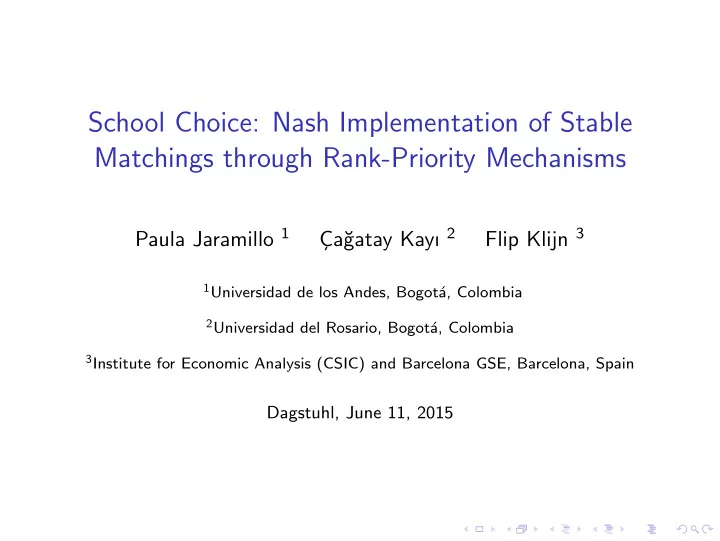

School Choice: Nash Implementation of Stable Matchings through Rank-Priority Mechanisms Paula Jaramillo 1 gatay Kayı 2 Flip Klijn 3 C ¸a˘ 1 Universidad de los Andes, Bogot´ a, Colombia 2 Universidad del Rosario, Bogot´ a, Colombia 3 Institute for Economic Analysis (CSIC) and Barcelona GSE, Barcelona, Spain Dagstuhl, June 11, 2015
School choice problem ◮ a set of students I = { i 1 , . . . , i n } , ◮ a set of schools S = { s 1 , . . . , s m } , ◮ a capacity vector q = ( q s 1 , q s 2 , . . . , q s m ), ◮ a list of strict student preferences P = ( P i 1 , . . . , P i n ) and ◮ a list of strict school priorities ≻ = ( ≻ s 1 , . . . , ≻ s m ).
Matchings ◮ A matching is a correspondence µ on the set I ∪ S such that ◮ for all i ∈ I , either µ ( i ) ∈ S or µ ( i ) = i , ◮ for all s ∈ S , | µ ( s ) | ≤ q s , and ◮ for all i ∈ I and s ∈ S , µ ( i ) = s ⇐ ⇒ i ∈ µ ( s ).
Stability/fairness ◮ µ is individually rational if for all i ∈ I and S ∈ S , µ ( i ) R i i ◮ µ is non-wasteful if there is no student i and a school s such that 1. s P i µ ( i ) and 2. | µ ( s ) | < q s ] ◮ student i has justified envy at µ if there is a school s such that 1. s P i µ ( i ) and 2. ∃ j ∈ µ ( s ) such that i ≻ s j . ◮ µ stable/fair if it is individually rational, non-wasteful, and no students have justified envy. ◮ Set of stable matchings Σ( P , ≻ ) � = ∅ .
Centralized mechanisms ◮ In school choice: (fixed) priorities are known to all students. ◮ A centralized mechanism ϕ assigns a matching to each problem P . Interpretation: each students submits an ordered list of schools and the clearinghouse employs an algorithm to obtain a matching (based on the priorities and the students’ submitted lists). ◮ Example: student-proposing deferred acceptance (DA) mechanism (Gale and Shapley, 1962).
Centralized mechanisms ◮ In school choice: (fixed) priorities are known to all students. ◮ A centralized mechanism ϕ assigns a matching to each problem P . Interpretation: each students submits an ordered list of schools and the clearinghouse employs an algorithm to obtain a matching (based on the priorities and the students’ submitted lists). ◮ Example: student-proposing deferred acceptance (DA) mechanism (Gale and Shapley, 1962). ◮ Another example...
Boston (immediate acceptance) mechanism: Round 1: Only the first choices of the students are considered. For each school, consider the students who have listed it as their first choice and assign seats of the school to these students one at a time following their priority order until either there are no seats left or there is no student left who has listed it as his first choice. Round k , k ≥ 2 : Consider the remaining students. Only the k -th choices of these students are considered. For each school with still available seats, consider the students who have listed it as their k -th choice and assign the remaining seats to these students one at a time following their priority order until either there are no seats left or there is no student left who has listed it as his k -th choice. The procedure terminates when each student is assigned a seat at a school.
Boston (immediate acceptance) mechanism ◮ The Boston mechanism induces a non-trivial preference revelation game.
Boston (immediate acceptance) mechanism ◮ The Boston mechanism induces a non-trivial preference revelation game. ◮ Ergin and S¨ onmez (2006, Theorem 1) showed that the set of Nash equilibrium outcomes coincides with the set of stable matchings!
Rank-Priority mechanisms ◮ Let a ( k , l ) match be a match between a student-school pair such that the student ranks the school k -th in her submitted preferences and she has the l -th priority at the school. ◮ Any bijection π : { 1 , . . . , n } × { 1 , . . . , m } − → { 1 , . . . , nm } defines a rank-priority mechanism as follows: ◮ Step 1: form any feasible π − 1 (1) match. ◮ Step 2: form any feasible π − 1 (1) match. ◮ . . . ◮ Step nm : form any feasible π − 1 ( nm ) match. ◮ Each student who remains unmatched after nm steps is matched to herself. ◮ Note: the Boston mechanism is a rank-priority mechanism. ◮ Ergin and S¨ onmez (2006, Theorem 4) showed that a rank-priority mechanism Nash implements the set of stable matchings if the mechanism is monotonic .
Our result A necessary and sufficient condition (on π ) for a rank-priority mechanism to Nash implement the set of stable matchings. (Too rough) a description of the condition: in the “beginning,” π is such that its ◮ first coordinate (ranks) is weakly decreasing, and ◮ second coordinate (priority) is weakly increasing.
Recommend
More recommend